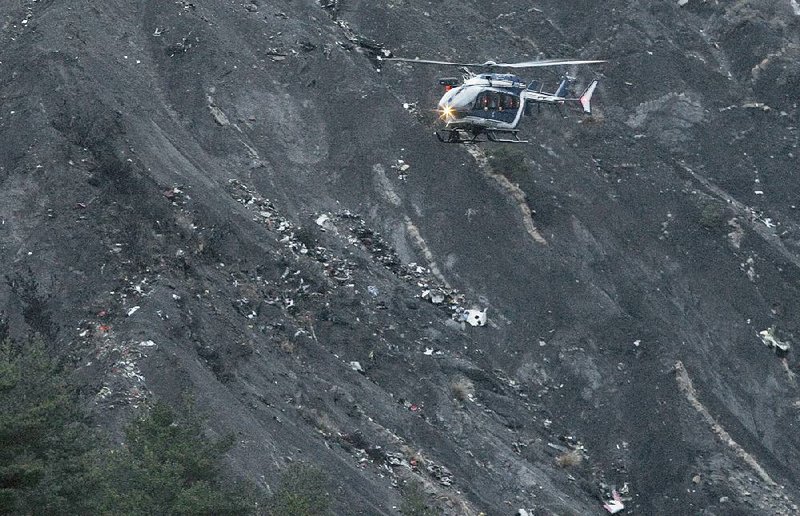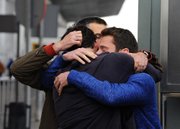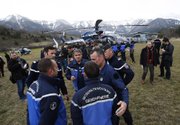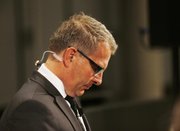PARIS -- A German jetliner on a flight to Duesseldorf, Germany, from Barcelona, Spain, rapidly lost altitude for more than eight minutes and crashed in the French Alps on Tuesday morning with 144 passengers and six crew members aboard, the airline said.
Helicopters and rescue personnel swarmed into the remote, rugged area in southeastern France after the crash but found no signs of life. Prime Minister Manuel Valls of France said no one on the plane had survived the crash.
The authorities and executives of the budget carrier Germanwings, a subsidiary of Lufthansa, had no immediate explanation for the cause of the crash, which occurred just before 11 a.m. At a news conference Tuesday evening, Heike Birlenbach, the vice president of Lufthansa, said that "at this stage, we consider this to be an accident," adding that everything else was speculation.
As night fell in the area, officials said they had recovered one of the jetliner's "black boxes" -- the cockpit voice recorder, which captures up to two hours of the pilots' conversations as well as other cockpit noises, including any alarms that would have sounded as the plane descended.
A few hours later, officials called off the search and rescue operation for the evening.
The plane, an Airbus A320, crashed after an eight-minute descent from 38,000 feet, the managing director of Germanwings, Thomas Winkelmann, said at a news conference.
When French air traffic controllers lost contact with the plane at 10:53 a.m., it was flying at just 6,000 feet, Winkelmann said, and it crashed shortly afterward. The terrain in that area rises to an elevation of more than 6,000 feet at some points.
As emergency crews combed the Alpes-de-Haute-Provence of southeastern France on Tuesday, Valls announced a judicial investigation into the crash.
Many questions remained, including whether the pilots were in control of the aircraft during the descent and what would have caused a plane with an experienced pilot and solid safety record to crash in largely clear and cloudless weather.
Among the passengers was a class of 16 German high school students and two teachers who were returning from a study program near Barcelona.
Some of their parents gathered at the airport in Duesseldorf, waiting for news and preparing for the worst.
"This is pretty much the worst thing you can imagine," said Bodo Klimpel, mayor of the German town of Haltern, where the 10th-grade students attended school.
As he spoke, people began arriving outside the high school in the city, bearing flowers and candles. Hundreds of people in the Spanish town where the students had been studying gathered later at a weekly Mass to mourn.
Authorities said 67 Germans were believed among the victims -- including the 16 high school students and two opera singers -- as well as many Spaniards, two Australians, and one person each from the Netherlands, Turkey and Denmark.
Contralto singer Maria Radner was returning to Germany with her husband and baby after performing in Wagner's Siegfried, according to Barcelona's Gran Teatre del Liceu. Bass baritone Oleg Bryjak had appeared in the same opera, according to the opera house in Duesseldorf.
Two employees of Delphi, an American automotive company, and at least one employee of Bayer, a German chemical company, also were among the passengers, according to Spanish media reports.
At El Prat Airport outside Barcelona, dozens of victims' relatives were kept in a waiting area, attended to by psychologists and protected by the police.
Meanwhile, the leaders of France, Spain and Germany made public addresses to offer comfort and reassurances that the crash would be investigated thoroughly. The National Assembly in France observed a minute of silence.
In Germany, Chancellor Angela Merkel expressed sympathy for the families of the victims, saying the crash was a "terrible shock."
"I feel terribly sorry, because so many people died in this disaster," she said. "Our thoughts and prayers are with these people."
Merkel said she would fly to southern France today to meet with authorities there.
Prime Minister Mariano Rajoy of Spain said he had spoken with Merkel and King Felipe VI of Spain, who cut short a state visit to Paris to return to Madrid on Tuesday.
"We are all deeply moved and will do everything we can to help the families of the victims," Rajoy said.
In Washington, the White House said American officials were in contact with their French, Spanish and German counterparts.
"There is no indication of a nexus to terrorism at this time," U.S. National Security Council spokesman Bernadette Meehan said.
'A picture of horror'
Earlier Tuesday, President Francois Hollande of France, standing with King Felipe VI, cautioned that access to the crash site was difficult.
The Interior Ministry in France said more than 400 police officers and rescue personnel had been sent to the area.
Hollande said that although none of the passengers were believed to be French, "we must feel grief because this is a tragedy that happened on our soil."
Bernard Cazeneuve, the French interior minister, said that "the violence of the shock" from the crash had left "little hope" there would be survivors. He warned against jumping to conclusions about the cause of the disaster.
German Foreign Minister Frank-Walter Steinmeier, who was flown over the crash scene Tuesday, said the site was "a picture of horror."
A helicopter crew that landed briefly in the area saw no signs of life, French officials said.
"Everything is pulverized. The largest pieces of debris are the size of a small car," said Gilbert Sauvan, president of the general council in Alpes-de-Haute-Provence.
Valls told the National Assembly in France that no hypothesis about the cause of the crash could be excluded.
A French official with direct knowledge of the investigation said investigators were seeking the second black box, the flight data recorder, which tracks roughly 1,300 different statistics -- including the plane's position, speed, altitude and direction.
Aviation safety experts said a descent of eight minutes from cruising altitude was slower than the 3-4 minutes that would normally be expected in the case of a sudden midair problem such as an aerodynamic stall, suggesting that the pilots may have been attempting to maintain control of the plane as it lost altitude.
"While investigators still need to verify the data are correct, eight minutes is definitely longer compared with the experience we have had in past cases," said Olivier Ferrante, a former crash investigator for the French Bureau of Investigations and Analyses who is now an adviser on aviation safety for the European Commission in Brussels.
In the case of the 2009 crash of an Air France flight over the Atlantic Ocean, an Airbus A330 took just 3½ minutes to fall from 38,000 feet to the surface of the ocean, Ferrante noted.
The crash zone of the Germanwings accident was significantly higher, meaning the plane would have had an even shorter vertical distance to travel before impact.
Ferrante said the small size of the pieces of debris from the crash suggested the plane hit the ground at a very high speed. He said it was too early to speculate about the cause of the crash.
Frederic Atger, a spokesman for Meteo France, which monitors weather across the country, said the conditions had been "particularly calm" in the area at the time of the crash.
"The visibility was good, and there were little clouds at low altitudes," he said.
The type of aircraft that crashed, an Airbus A320 single-aisle jet, is a workhorse of many airline fleets, with more than 5,600 in service around the world. More than 1 billion passengers have flown on jets in the A320 series -- which includes a smaller version, the A319, and a stretched model, the A321 -- in the past year, according to estimates by Ascend, a London-based aviation consulting firm.
The aircraft's safety record has been very good but not spotless. Since entering into service in 1988, A320 aircraft have been involved in 12 fatal accidents, according to Ascend.
Germanwings, based in Cologne, was founded in 2002 and acquired by Lufthansa in 2009. It has since grown to become Lufthansa's main operator for domestic and short-distance European flights from cities other than the main hubs of Munich and Frankfurt.
It has a fleet of about 81 planes, of which about two-thirds are Airbus A320s and A319s.
The aircraft that crashed Tuesday was delivered to Lufthansa in 1991 and had about 58,300 flight hours in about 46,700 flights, Airbus said. The plane underwent a routine check in Duesseldorf on Monday, and its last regular full check took place in the summer of 2013.
Tuesday's crash was Germanwings' first involving passenger deaths since it began operating in 2002.
It was the deadliest crash on French territory since a 1981 crash of a Yugoslavian airliner in Corsica, which killed 180. The deadliest crash in France occurred in 1974, when a Turkish Airlines DC-10 crashed outside Paris, killing more than 335 people.
Lufthansa Chief Executive Officer Carsten Spohr called Tuesday the "blackest day of our company's 60-year history."
Spohr said Tuesday evening that Germanwings had to cancel seven flights out of Dusseldorf because a number of crew members felt they were unfit to fly after news of the accident.
"One must not forget: Many of our Germanwings crews have known crew members who were onboard the crashed plane," Spohr said.
At a news conference earlier Tuesday, Spohr said flying "remains after this terrible day the safest mode of transport."
At the Duesseldorf airport Tuesday afternoon, a small crowd of people stood around a television set at a cafe in the departure area as Germanwings officials spoke at a news conference about the crash.
Among the people at the cafe were Patrick Huber, 25, and Helena Henkel, 26, who wore backpacks and said they were on their way to Barcelona for an 11-day vacation on the Spanish coast.
"On Germanwings," Huber said, with a nervous laugh. But he said they would fly anyway.
"Still," he added, "I'll be happy when we land."
Information for this article was contributed by Nicola Clark, Dan Bilefsky, Maia de la Baume, Aurelien Breeden, Laure Fourquet, Alissa J. Rubin, Melissa Eddy, Alison Smale, Jack Ewing and Raphael Minder of The New York Times; and by Greg Keller, Angela Charlton, Lori Hinnant, Thomas Adamson, Elaine Ganley, Claude Paris, David McHugh, Geir Moulson, David Rising, Frank Augstein, Al Clendenning, Joe Wilson, Kirsten Grieshaber, Scott Mayerowitz and staff members of The Associated Press.



